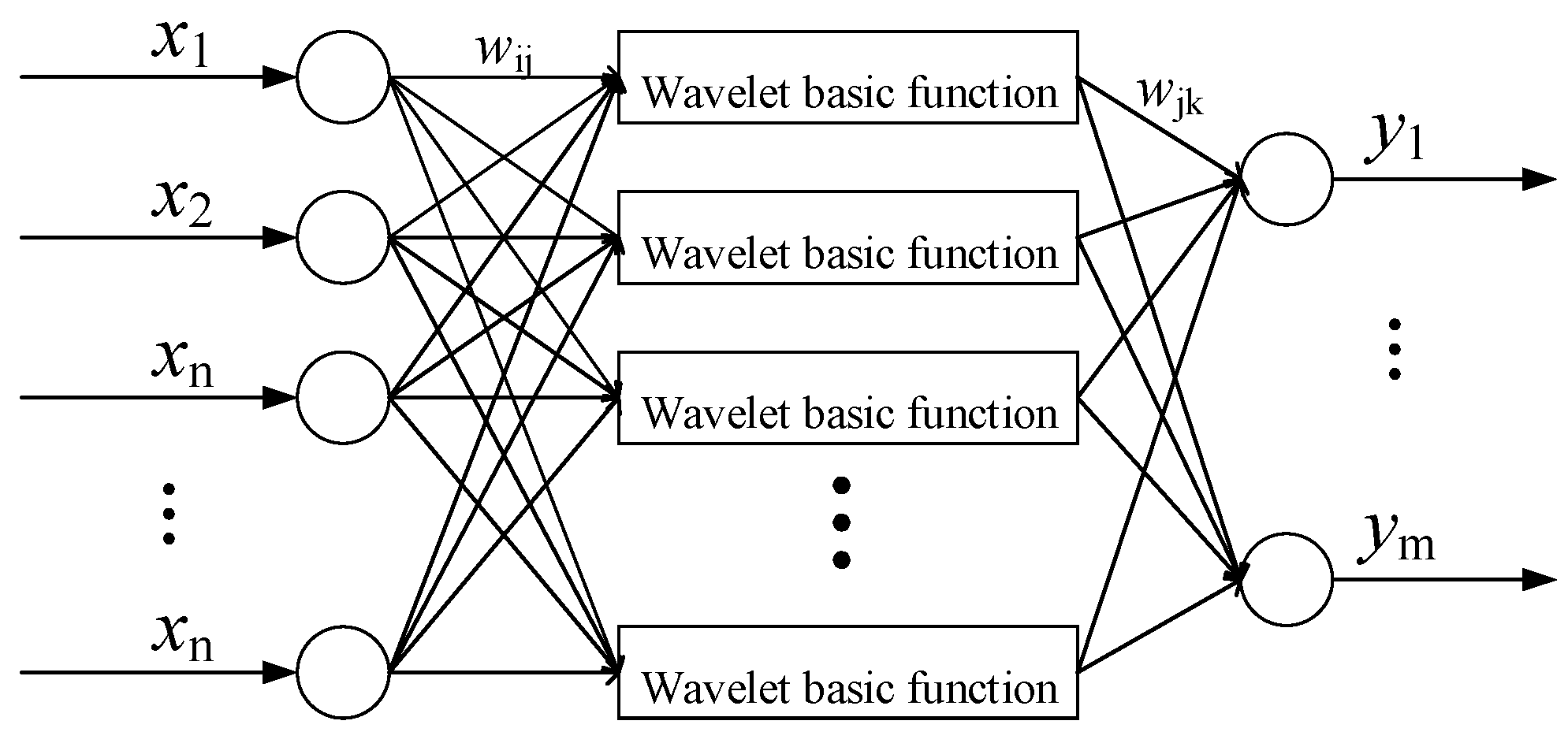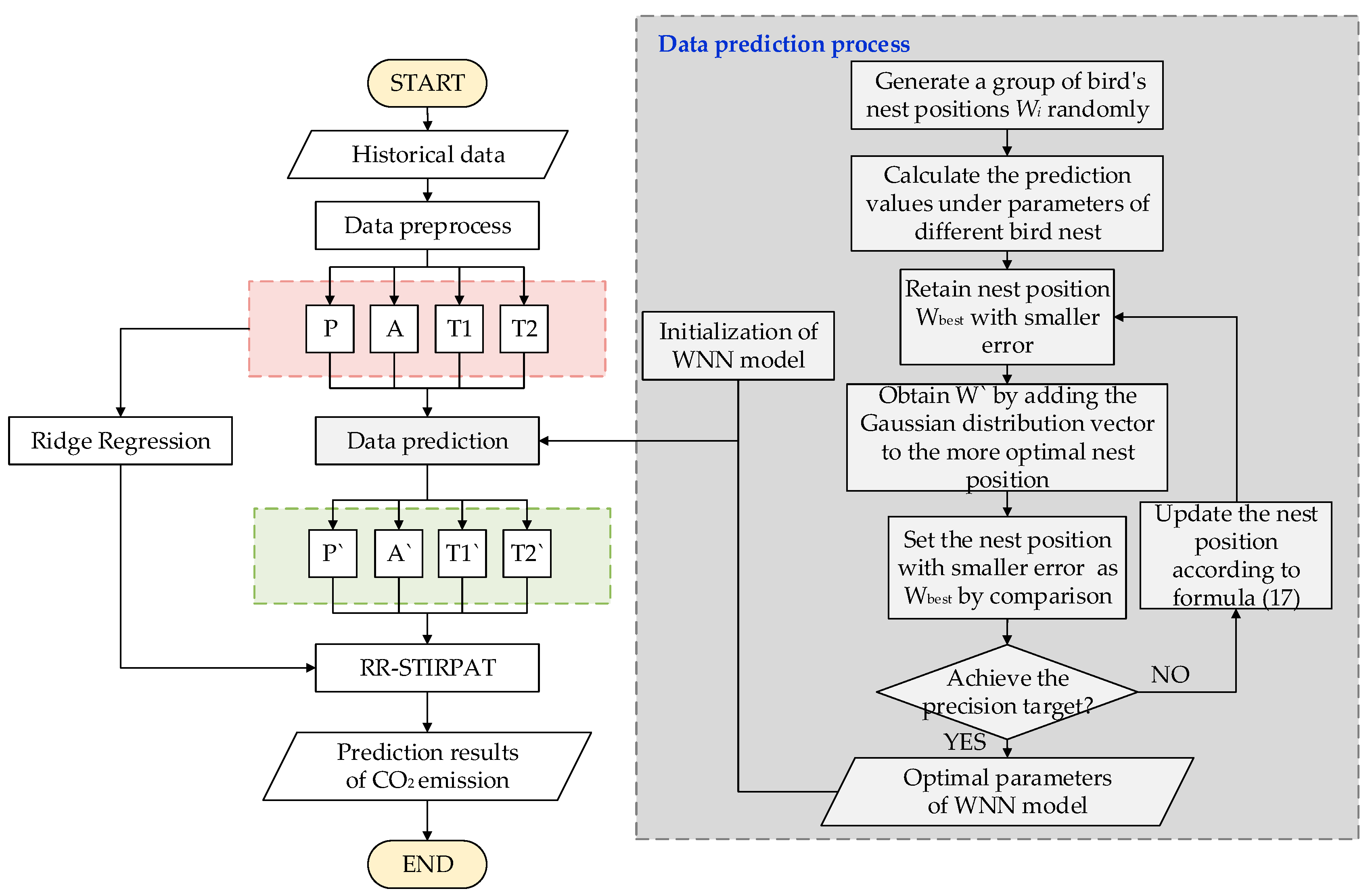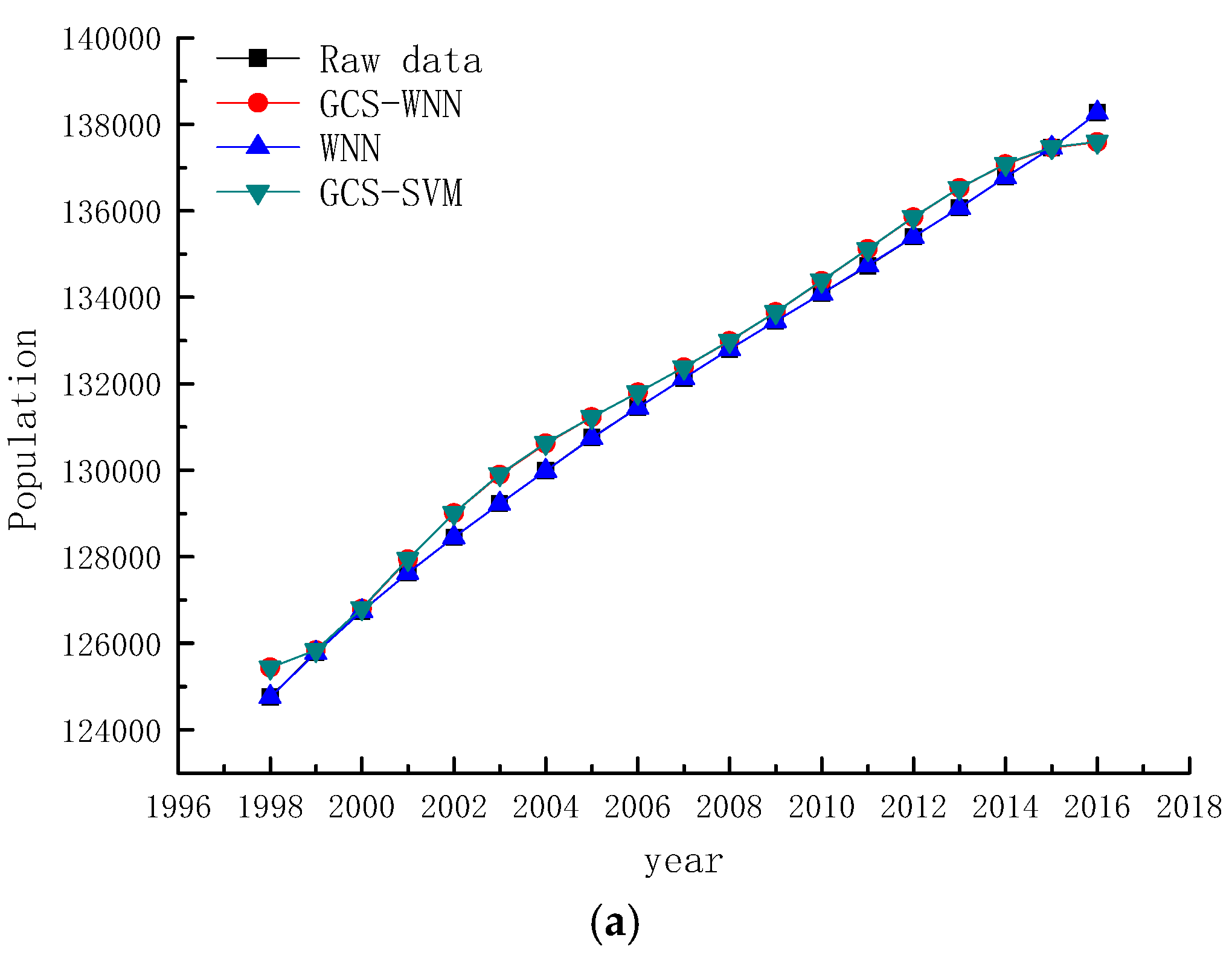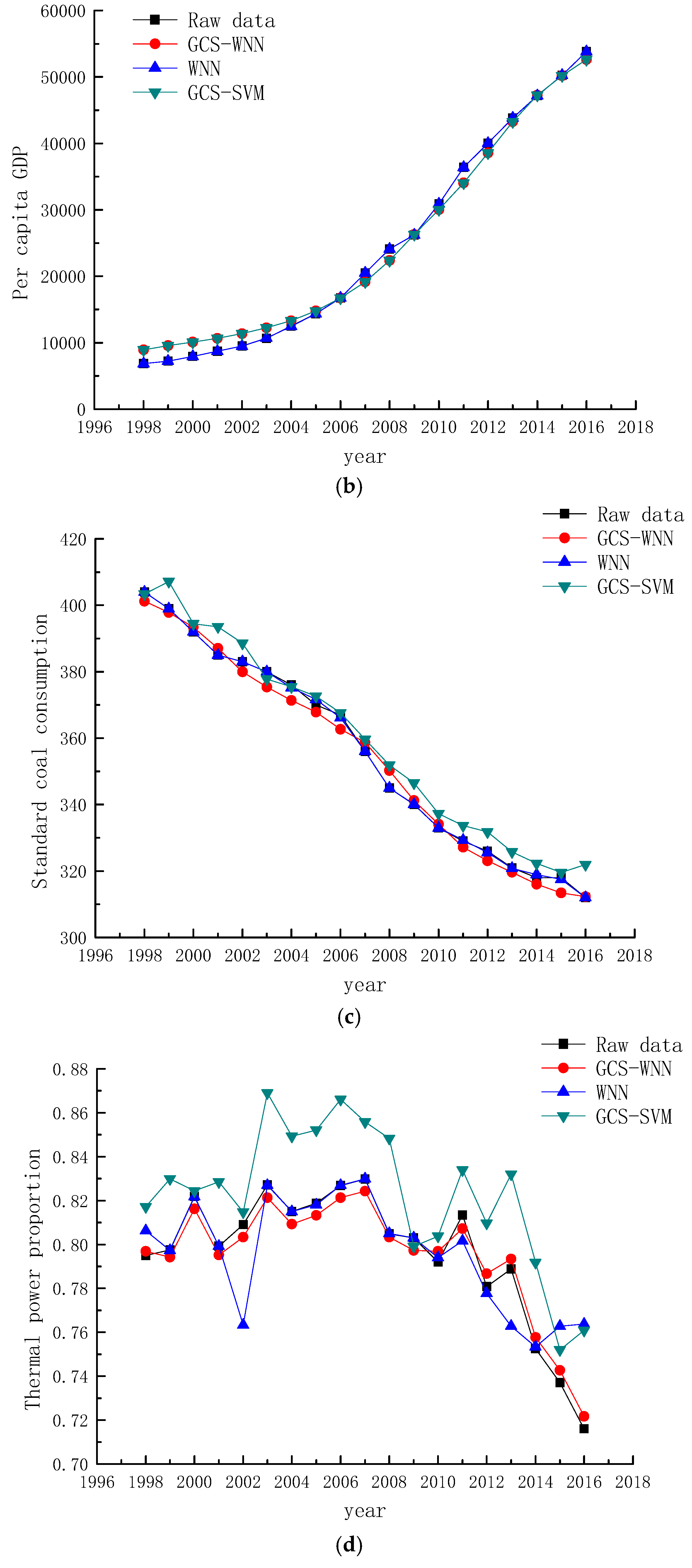Prediction of CO2 Emission in China’s Power Generation Industry with Gauss Optimized Cuckoo Search Algorithm and Wavelet Neural Network Based on STIRPAT model with Ridge Regression
Abstract
:1. Introduction
2. Materials and Methods
2.1. STIRPAT Model
2.2. Ridge Regression
2.3. Wavelet Neural Network Prediction Model
2.4. Gauss Optimized Cuckoo Search Algorithm
2.4.1. Cuckoo Search Algorithm
- (1)
- The number of eggs produced by a cuckoo per time is 1.
- (2)
- The host bird’s nest where high-quality eggs are located is the optimal solution and will be retained for the next generation.
- (3)
- The number of host nests is certain, and the probability that cuckoo eggs are found by nest owners is .
2.4.2. Gauss Optimization
2.5. The Prediction Model of RR-STIRPAT-GCS-WNN
3. Results
3.1. Analysis on Influencing Factors of CO2 Emission in Power Generation Industry
3.2. Prediction of CO2 Emission in Power Generation Industry
3.2.1. Prediction of Influencing Factors Based on GCS-WNN
3.2.2. Prediction of CO2 Emission Based on RR-STIRPAT Model
4. Discussion and Conclusions
- (1)
- The CO2 emission of power generation industry is affected by many factors. It is concluded that the key factors that directly affect CO2 emissions are population, per capita GDP, standard coal consumption and proportion of thermal power.
- (2)
- Based on the STIRPAT model, the CO2 emission factors analysis model of power generation industry is established. Besides, the collinearity test of the model shows that if the ordinary least squares algorithm is applied, the multicollinearity will be serious. However, the ridge regression method can solve this problem to a certain extent.
- (3)
- The WNN model is used to predict the influencing factors. In order to improve the convergence speed and prediction accuracy of the model, Gauss optimized cuckoo search algorithm is added into the model parameter optimization. Compared with other models, it is found that the optimized model has higher prediction accuracy.
- (4)
- The GCS-WNN model is used to predict the population, per capita GDP, standard coal consumption and the proportion of thermal power in the past 2018–2022 years. The predicted results of each factor are plugged into the RR-STIRPAT model, and finally the CO2 emission prediction value of 2018–2022 years power generation industry is obtained. It is predicted that the CO2 emission from the power generation industry will increase gradually in the next five years. However, with the slowdown of population growth and the development of power generation technology, CO2 emissions in power generation industry will grow slower and slower.
Supplementary Files
Supplementary File 1Acknowledgments
Author Contributions
Conflicts of Interest
References
- The Electric Power Development Planning “in 13th Five-Year” (2016–2020 (Full Text). Available online: http://news.bjx.com.cn/html/20161222/798873.shtml (accessed on 22 December 2016).
- Liu, L.; Zong, H.; Zhao, E.; Chen, C.; Wang, J. Can China realize its carbon emission reduction goal in 2020: From the perspective of thermal power development. Appl. Energy 2014, 124, 199–212. [Google Scholar] [CrossRef]
- Seo, Y.; Ide, K.; Kitahata, N.; Kuchitsu, K.; Dowaki, K. Environmental Impact and Nutritional Improvement of Elevated CO2 Treatment: A Case Study of Spinach Production. Sustainability 2017, 9, 1854. [Google Scholar] [CrossRef]
- Shahbaz, M.; Loganathan, N.; Muzaffar, A.T.; Ahmed, K.; Jabran, M.A. How urbanization affects CO2, emissions in Malaysia? The application of STIRPAT model. Renew. Sustain. Energy Rev. 2016, 57, 83–93. [Google Scholar] [CrossRef]
- Wang, C.; Wang, F.; Zhang, X.; Yang, Y.; Su, Y.; Ye, Y.; Zhang, H. Examining the driving factors of energy related carbon emissions using the extended STIRPAT model based on IPAT identity in Xinjiang. Renew. Sustain. Energy Rev. 2017, 67, 51–61. [Google Scholar] [CrossRef]
- Shahbaz, M.; Chaudhary, A.R.; Ozturk, I. Does urbanization cause increasing energy demand in Pakistan? Empirical evidence from STIRPAT model. Energy 2017, 122, 83–93. [Google Scholar] [CrossRef]
- Shuai, C.; Shen, L.; Jiao, L.; Wu, Y.; Tan, Y. Identifying key impact factors on carbon emission: Evidences from panel and time-series data of 125 countries from 1990 to 2011. Appl. Energy 2017, 187, 310–325. [Google Scholar] [CrossRef]
- Wang, P.; Wu, W.; Zhu, B.; Wei, Y. Examining the impact factors of energy-related CO2 emissions using the STIRPAT model in Guangdong Province, China. Appl. Energy 2013, 106, 65–71. [Google Scholar] [CrossRef]
- Li, W.; Sun, S. Air pollution driving factors analysis: Evidence from economically developed area in China. Environ. Prog. Sustain. Energy 2016, 35, 1231–1239. [Google Scholar] [CrossRef]
- Al-Mulali, U.; Fereidouni, H.G.; Lee, J.Y.M.; Normee Che Sab, C. Exploring the relationship between urbanization, energy consumption, and CO2 emission in MENA countries. Renew. Sustain. Energy Rev. 2013, 23, 107–112. [Google Scholar] [CrossRef]
- Zhang, C.; Liu, C. The impact of ICT industry on CO2 emissions: A regional analysis in China. Renew. Sustain. Energy Rev. 2015, 44, 12–19. [Google Scholar] [CrossRef]
- Xie, C.; Hawkes, A.D.; Lund, H. Estimation of inter-fuel substitution possibilities in China’s transport industry using ridge regression. Energy 2015, 88, 260–267. [Google Scholar] [CrossRef]
- Yue, Y.; Li, M.; Zhu, A.X.; Ye, X.; Mao, R.; Wan, J.; Dong, J. Land Degradation Monitoring in the Ordos Plateau of China Using an Expert Knowledge and BP-ANN-Based Approach. Sustainability 2016, 8, 1174. [Google Scholar] [CrossRef]
- Kumar, U.; Jain, V.K. Time series models (Grey-Markov, Grey Model with rolling mechanism and singular spectrum analysis) to forecast energy consumption in India. Energy 2010, 35, 1709–1716. [Google Scholar] [CrossRef]
- Li, S.; Li, R. Comparison of forecasting energy consumption in Shandong, China Using the ARIMA model, GM model, and ARIMA-GM model. Sustainability 2017, 9, 1181. [Google Scholar] [CrossRef]
- Xu, J.; Ren, Q.; Shen, Z. Prediction of the strength of concrete radiation shielding based on LS-SVM. Ann. Nucl. Energy 2015, 85, 296–300. [Google Scholar]
- Gao, Y.; Cheng, H.; Zhu, J.; Liang, H.; Li, P. The Optimal Dispatch of a Power System Containing Virtual Power Plants under Fog and Haze Weather. Sustainability 2016, 8, 71. [Google Scholar] [CrossRef]
- Nieto, P.J.G.; García-Gonzalo, E.; Fernández, J.R.A.; Díaz Muñizb, C. A hybrid PSO optimized SVM-based model for predicting a successful growth cycle of the Spirulina platensis, from raceway experiments data. Ecol. Eng. 2015, 81, 534–542. [Google Scholar] [CrossRef]
- Kim, H.; Baek, S.; Choi, K.; Kim, D.; Lee, S.; Kim, D.; Chang, H.J. Comparative Analysis of On- and Off-Grid Electrification: The Case of Two South Korean Islands. Sustainability 2016, 8, 350. [Google Scholar] [CrossRef]
- Zhang, F.; Dong, Y.; Zhang, K. A Novel Combined Model Based on an Artificial Intelligence Algorithm—A Case Study on Wind Speed Forecasting in Penglai, China. Sustainability 2016, 8, 555. [Google Scholar] [CrossRef]
- Gao, C.; Wang, K. Micro-grid power forecast based on MSC-WNN model. Electr. Meas. Instrum. 2015, 52, 68–73. [Google Scholar]
- Wang, Z.; Wang, C.; Wu, J. Wind Energy Potential Assessment and Forecasting Research Based on the Data Pre-Processing Technique and Swarm Intelligent Optimization Algorithms. Sustainability 2016, 8, 1191. [Google Scholar] [CrossRef]
- York, R.; Rosa, E.A.; Dietz, T. STIRPAT, IPAT and ImPACT: Analytic tools for unpacking the driving forces of environmental impacts. Ecol. Econ. 2003, 46, 351–365. [Google Scholar] [CrossRef]
- Yu, X.; Geng, Y.; Dong, H.; Ulgiati, S.; Liu, Z.; Liu, Z.; Ma, Z.; Tian, X.; Sun, L. Sustainability assessment of one industrial region: A combined method of emergy analysis and IPAT (Human Impact Population Affluence Technology). Energy 2016, 107, 818–830. [Google Scholar] [CrossRef]
- Dong, J.F.; Wang, Q.; Deng, C.; Wang, X.-M.; Zhang, X.-L. How to Move China toward a Green-Energy Economy: From a Sector Perspective. Sustainability 2016, 8, 337. [Google Scholar] [CrossRef]
- Zhang, Z.; Chen, X.; Heck, P. Emergy-Based Regional Socio-Economic Metabolism Analysis: An Application of Data Envelopment Analysis and Decomposition Analysis. Sustainability 2014, 6, 8618–8638. [Google Scholar] [CrossRef]
- Liu, Y.; Yang, Z.; Wu, W. Assessing the impact of population, income and technology on energy consumption and industrial pollutant emissions in China. Appl. Energy 2015, 155, 904–917. [Google Scholar] [CrossRef]
- Li, K.; Lin, B. Impacts of urbanization and industrialization on energy consumption/CO2, emissions: Does the level of development matter? Renew. Sustain. Energy Rev. 2015, 52, 1107–1122. [Google Scholar] [CrossRef]
- Marquardt, D.W.; Snee, R.D. Ridge Regression in Practice. Am. Stat. 1975, 29, 3–20. [Google Scholar]
- Hoerl, A.E.; Kennard, R.W. Ridge Regression: Applications to Nonorthogonal Problems. Technometrics 1970, 12, 69–82. [Google Scholar] [CrossRef]
- Hoerl, A.E.; Kennard, R.W. Ridge Regression: Biased Estimation for Nonorthogonal Problems. Technometrics 2000, 42, 80–86. [Google Scholar] [CrossRef]
- Feng, Y.; Cui, N.; Zhao, L.; Hu, X.; Gong, D. Comparison of ELM, GANN, WNN and empirical models for estimating reference evapotranspiration in humid region of Southwest China. J. Hydrol. 2016, 536, 376–383. [Google Scholar] [CrossRef]
- Ganjefar, S.; Tofighi, M. Single-hidden-layer fuzzy recurrent wavelet neural network: Applications to function approximation and system identification. Inf. Sci. 2015, 294, 269–285. [Google Scholar] [CrossRef]
- Wang, W.; Zhang, M.; Liu, X. Improved fruit fly optimization algorithm optimized wavelet neural network for statistical data modeling for industrial polypropylene melt index prediction. J. Chemometr. 2015, 29, 506–513. [Google Scholar] [CrossRef]
- Kasiviswanathan, K.S.; He, J.; Sudheer, K.P.; Tay, J.-H. Potential application of wavelet neural network ensemble to forecast streamflow for flood management. J. Hydrol. 2016, 536, 161–173. [Google Scholar] [CrossRef]
- Walton, S.; Hassan, O.; Morgan, K.; Brown, M.R. Modified cuckoo search: A new gradient free optimisation algorithm. Chaos Solitons Fract. 2011, 44, 710–718. [Google Scholar] [CrossRef]
- Ahmed, J.; Salam, Z. A Maximum Power Point Tracking (MPPT) for PV system using Cuckoo Search with partial shading capability. Appl. Energy 2014, 119, 118–130. [Google Scholar] [CrossRef]
- Nguyen, T.T.; Vo, D.N.; Truong, A.V. Cuckoo search algorithm for short-term hydrothermal scheduling. Appl. Energy 2014, 132, 276–287. [Google Scholar] [CrossRef]
- Li, X.T.; Yin, M.H. A hybrid cuckoo search via Lévy flights for the permutation flow shop scheduling problem. Int. J. Prod. Res. 2013, 51, 732–4754. [Google Scholar] [CrossRef]
- Zheng, H.; Zhou, Y. A novel Cuckoo Search optimization algorithm base on gauss distribution. J. Comput. Inf. Syst. 2012, 8, 4193–4200. [Google Scholar]
- Lai, J.; Liang, S.; Center, C. Application of GCS-SVM model in network traffic prediction. Comput. Eng. Appl. 2013, 49, 75–78. [Google Scholar]








| Year | CO2 Annual Emissions (million tons) | Population (million people) | Per Capita GDP (yuan) | Standard Coal Consumption (g/kWh) | Proportion of Thermal Power |
|---|---|---|---|---|---|
| 1995 | 915.36 | 1211.21 | 5091 | 412 | 0.795 |
| 1996 | 1005.78 | 1223.89 | 5898 | 410 | 0.813 |
| 1997 | 1022.69 | 1236.26 | 6481 | 408 | 0.815 |
| 1998 | 1021.78 | 1247.61 | 6860 | 404 | 0.795 |
| 1999 | 1053.64 | 1257.86 | 7229 | 399 | 0.798 |
| 2000 | 1082.86 | 1267.43 | 7942 | 392 | 0.822 |
| 2001 | 1145.20 | 1276.27 | 8717 | 385 | 0.799 |
| 2002 | 1300.08 | 1284.53 | 9506 | 383 | 0.809 |
| 2003 | 1542.09 | 1292.27 | 10,666 | 380 | 0.827 |
| 2004 | 1822.60 | 1299.88 | 12,487 | 376 | 0.815 |
| 2005 | 2036.69 | 1307.56 | 14,368 | 370 | 0.819 |
| 2006 | 2321.18 | 1314.48 | 16,738 | 367 | 0.827 |
| 2007 | 2538.77 | 1321.29 | 20,505 | 356 | 0.830 |
| 2008 | 2625.22 | 1328.02 | 24,121 | 345 | 0.805 |
| 2009 | 2793.57 | 1334.50 | 26,222 | 340 | 0.803 |
| 2010 | 3099.39 | 1340.91 | 30,876 | 333 | 0.792 |
| 2011 | 3537.78 | 1347.35 | 36,403 | 329 | 0.813 |
| 2012 | 3600.12 | 1354.04 | 40,007 | 326 | 0.781 |
| 2013 | 3749.21 | 1360.72 | 43,852 | 321 | 0.789 |
| 2014 | 3904.66 | 1367.82 | 47,203 | 318 | 0.752 |
| 2015 | 4042.31 | 1374.62 | 50,251 | 318 | 0.737 |
| 2016 | 4162.96 | 1382.71 | 53,817 | 312 | 0.716 |
| Model | R | R2 | Adjusted R2 | Std. Error of the Estimate |
|---|---|---|---|---|
| 1 | 0.996 | 0.992 | 0.991 | 0.05326 |
| Model | Sum of Squares | df | Mean Square | F | Significance (Sig.) | |
|---|---|---|---|---|---|---|
| 1 | Regression | 6.299 | 4 | 1.575 | 555.098 | 0.000 |
| Residual | 0.048 | 17 | 0.003 | |||
| Total | 6.347 | 21 | ||||
| Model | Unstandardized Coefficients | Standardized Coefficients | t | Sig. | Collinearity Statistics | |||
|---|---|---|---|---|---|---|---|---|
| B | Std. Error | Beta | Tolerance | VIF | ||||
| 1 | (Constant) | −16.678 | 21.648 | −0.770 | 0.452 | |||
| ln P | −0.547 | 1.529 | −0.039 | −0.358 | 0.725 | 0.038 | 26.232 | |
| ln A | 1.227 | 0.205 | 1.770 | 5.995 | 0.000 | 0.005 | 194.998 | |
| ln T1 | 4.020 | 1.665 | 0.695 | 2.413 | 0.027 | 0.005 | 185.319 | |
| ln T2 | 1.191 | 0.424 | 0.081 | 2.813 | 0.012 | 0.533 | 1.878 | |
| Model | Dimension | Eigenvalue | Condition Index | Variance Proportions | ||||
|---|---|---|---|---|---|---|---|---|
| (Constant) | ln P | ln A | ln T1 | ln T2 | ||||
| 1 | 1 | 4.976 | 1.000 | 0.00 | 0.00 | 0.00 | 0.00 | 0.00 |
| 2 | 0.020 | 15.721 | 0.00 | 0.00 | 0.00 | 0.00 | 0.48 | |
| 3 | 0.004 | 36.975 | 0.00 | 0.00 | 0.01 | 0.00 | 0.33 | |
| 4 | 9.050 × 10−7 | 2344.946 | 0.03 | 0.15 | 0.98 | 0.79 | 0.03 | |
| 5 | 1.718 × 10−7 | 5382.577 | 0.97 | 0.85 | 0.01 | 0.21 | 0.15 | |
| Mult R | R2 | Adjusted R2 | SE |
|---|---|---|---|
| 0.9801579272 | 0.9607095623 | 0.9514647534 | 0.1211139063 |
| df | SS | MS | F Value | Sig. F | |
|---|---|---|---|---|---|
| Regress | 4.000 | 6.097 | 1.524 | 103.9188127 | 0.0000000 |
| Residual | 17.000 | 0.249 | 0.015 |
| B | SE(B) | Beta | B/SE(B) | |
|---|---|---|---|---|
| ln P | 3.92423625 | 0.30690079 | 0.27792333 | 12.78666051 |
| ln A | 0.21204247 | 0.01169894 | 0.30586681 | 18.12492455 |
| ln T1 | −1.65055241 | 0.09696411 | −0.28521636 | −17.02230296 |
| ln T2 | −0.16815311 | 0.51870654 | −0.01150223 | −0.32417772 |
| Constant | −26.39759673 | 3.47936456 | 0.00000000 | −7.58690166 |
| Year | Population (million people) | Per Capita GDP (yuan) | Standard Coal Consumption (g/kWh) | Proportion of Thermal Power |
|---|---|---|---|---|
| 2018 | 1379.12 | 59,894 | 307.4795 | 0.6879 |
| 2019 | 1380.15 | 61,761 | 304.9642 | 0.6698 |
| 2020 | 1381.56 | 64,597 | 301.4681 | 0.6514 |
| 2021 | 1383.69 | 66,717 | 299.1497 | 0.6498 |
| 2022 | 1385.14 | 69,486 | 297.3476 | 0.6389 |
| Year | CO2 (Unit: million tons) |
|---|---|
| 2018 | 4347.48 |
| 2019 | 4468.63 |
| 2020 | 4638.16 |
| 2021 | 4760.55 |
| 2022 | 4883.71 |
© 2017 by the authors. Licensee MDPI, Basel, Switzerland. This article is an open access article distributed under the terms and conditions of the Creative Commons Attribution (CC BY) license (http://creativecommons.org/licenses/by/4.0/).
Share and Cite
Zhao, W.; Niu, D. Prediction of CO2 Emission in China’s Power Generation Industry with Gauss Optimized Cuckoo Search Algorithm and Wavelet Neural Network Based on STIRPAT model with Ridge Regression. Sustainability 2017, 9, 2377. https://doi.org/10.3390/su9122377
Zhao W, Niu D. Prediction of CO2 Emission in China’s Power Generation Industry with Gauss Optimized Cuckoo Search Algorithm and Wavelet Neural Network Based on STIRPAT model with Ridge Regression. Sustainability. 2017; 9(12):2377. https://doi.org/10.3390/su9122377
Chicago/Turabian StyleZhao, Weibo, and Dongxiao Niu. 2017. "Prediction of CO2 Emission in China’s Power Generation Industry with Gauss Optimized Cuckoo Search Algorithm and Wavelet Neural Network Based on STIRPAT model with Ridge Regression" Sustainability 9, no. 12: 2377. https://doi.org/10.3390/su9122377
APA StyleZhao, W., & Niu, D. (2017). Prediction of CO2 Emission in China’s Power Generation Industry with Gauss Optimized Cuckoo Search Algorithm and Wavelet Neural Network Based on STIRPAT model with Ridge Regression. Sustainability, 9(12), 2377. https://doi.org/10.3390/su9122377





